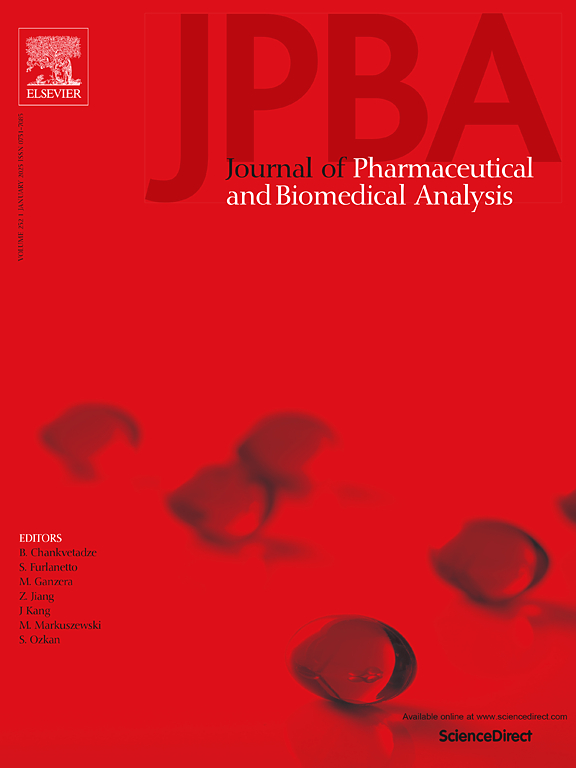Development and optimization of a high-throughput LC-MS/MS method for the simultaneous determination of Exatecan and its Cathepsin B-sensitive prodrug, and ARV-825 in rat plasma: Application to pharmacokinetic study
IF 3.1
3区 医学
Q2 CHEMISTRY, ANALYTICAL
Journal of pharmaceutical and biomedical analysis
Pub Date : 2025-02-12
DOI:10.1016/j.jpba.2025.116746
引用次数: 0
Abstract
For most cancers, the combination of chemotherapy drugs is a promising approach. The combination of DNA damage agent Exatecan and proteolysis targeting chimera (PROTAC) agent ARV-825, which is a selective bromodomain-containing protein 4 degrader, can further improve efficacy through the DNA damage-repair mechanism. The Cathepsin B-sensitive prodrug with high albumin affinity of Exatecan (C14-VC-PAB-Exa) was introduced and co-encapsulated with ARV-825 into the nano-drug delivery system for improving the physicochemical properties of the two drugs. To promote the translation of Exatecan and the PROTAC into the clinics, it is important to develop a reliable and high-throughput bioanalytical method for the simultaneous determination of Exatecan, C14-VC-PAB-Exa, and ARV-825 that can evaluate the pharmacokinetic behaviors of the analytes. In this study, an HPLC-MS/MS method after preparation by one-step protein precipitation was developed and fully validated. The analytes were eluted completely on a ZORBAX SB-C18 column by gradient elution. Multiple reaction monitoring mode with positive electrospray ionization was applied to quantify the analytes. The validated method on selectivity, linearity (r ≥ 0.995), precision and accuracy (< 15 %), extraction recovery (> 88.0 %), matrix effect (< 9.1 %), carry-over, and stability were within the predefined acceptance criteria. The method was successfully applied to the pharmacokinetic study of Exatecan, C14-VC-PAB-Exa, and ARV-825 in rats for the first time. The proposed robust and economical method will be an alternative bioanalytical procedure for Exatecan and ARV-825 in the future. What is more, the present work could provide a reference for the clinical combination of the two drugs.
求助全文
约1分钟内获得全文
求助全文
来源期刊
CiteScore
6.70
自引率
5.90%
发文量
588
审稿时长
37 days
期刊介绍:
This journal is an international medium directed towards the needs of academic, clinical, government and industrial analysis by publishing original research reports and critical reviews on pharmaceutical and biomedical analysis. It covers the interdisciplinary aspects of analysis in the pharmaceutical, biomedical and clinical sciences, including developments in analytical methodology, instrumentation, computation and interpretation. Submissions on novel applications focusing on drug purity and stability studies, pharmacokinetics, therapeutic monitoring, metabolic profiling; drug-related aspects of analytical biochemistry and forensic toxicology; quality assurance in the pharmaceutical industry are also welcome.
Studies from areas of well established and poorly selective methods, such as UV-VIS spectrophotometry (including derivative and multi-wavelength measurements), basic electroanalytical (potentiometric, polarographic and voltammetric) methods, fluorimetry, flow-injection analysis, etc. are accepted for publication in exceptional cases only, if a unique and substantial advantage over presently known systems is demonstrated. The same applies to the assay of simple drug formulations by any kind of methods and the determination of drugs in biological samples based merely on spiked samples. Drug purity/stability studies should contain information on the structure elucidation of the impurities/degradants.

 求助内容:
求助内容: 应助结果提醒方式:
应助结果提醒方式:


